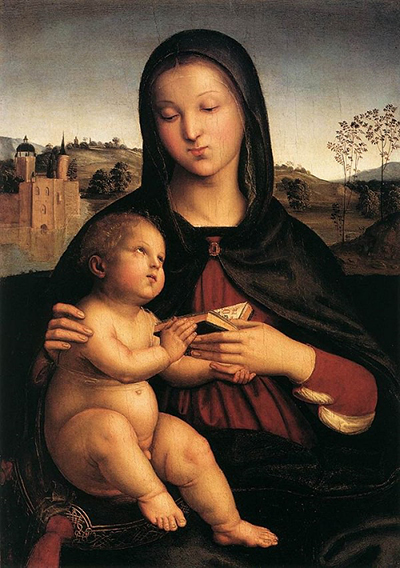Raphael's Madonna and Child with the Book, completed circa 1503, presents an idealised and iconic juxtaposition of Mary, mother of Jesus, and Christ as a young child
Christ is depicted as naked and helpless – although with a curiously precocious and strong-willed look in his eyes as he gazes up into the face of his mother, the Madonna.
Mary herself, draped in a rich black cloak, appears calm and tranquil as she surveys her young child, while supporting him carefully with her arm. With her other hand she holds a book with a Latin inscription on the page, as the Christ-child's much smaller hand reaches forward to grasp this offering.
The inscription on the page refers to the Nones, or ninth-hour of the Divine Office of the traditional Christian liturgy, which commemorates the crucifixion and death of Jesus Christ, and his ascension to heaven.
With its simple, pyramidal composition and lush (though not overpowering) colours, the painting is typical of Raphael's portraits (such as his Portrait of Pope Julius II, Portrait of Bindo Altoviti, and Portrait of Elisabetta Gonzaga) - and more broadly of the painting style of the High Renaissance itself.
The grand religious theme, exaggerated, stylised pose, and idealised surroundings mark the painting as a fine example of proto-Mannerism – with Raphael himself being a key figure in the later popularising of what would come to be referred to by historians as Mannerism.
The artistic style and themes of Mannerism would go on to gain traction and influence shortly after Raphael's death.
The Madonna-and-child image is a recurring motif of the Renaissance period, with numerous painters and artists of the Italian Renaissance (and thus contemporaries or near-contemporaries of Raphael) producing Madonna-and-child scenes – either in paintings, or in the form of sculptures.
Notable works in this particular category include Michelangelo's marble works Madonna of the Stairs (circa 1491) and Medici Madonna, as well as Leonardo da Vinci's Virgin of the Rocks (circa 1486), and his Virgin and Child with St Anne (circa 1503).
Others include Sandro Botticelli's The Madonna of the Book (circa 1480), and Titian's Madonna and Child with Mary Magdalene (circa 1560). Although the Madonna-and-child image is closely associated with the Renaissance, its roots can be traced as far back as the 2nd century – where it featured on the ancient Catacombs of Rome.




